COUNTDOWN!
©1995 Michael R. Grabois and Astra Enterprises
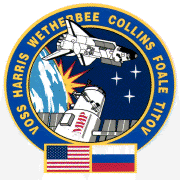
|
NOTE 1: What follows is an account of my participation in the
STS-63 launch on Jan. 31-Feb. 2, 1995, written the day after the launch. I condensed some roles and left out some steps for clarity. You can also see the official NASA timeline of a countdown.
NOTE 2: This account is not sponsored or approved by NASA in any way.
Links last updated November 11, 2001.
|
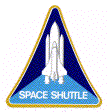
|
Last night the space shuttle launched into an orbit that will take it to a rendezvous with the Russian space station Mir ("peace" in Russian; it looks like "M-backwards N-P" in Cyrillic). As some of you may know, I helped out in Mission Control Center (MCC) at the Johnson Space Center in Houston for this flight. What follows is a behind-the-scenes look at the preparations for a shuttle launch, from my point of view.

 First, I must give you some background into what I do in MCC. Mission Control is staffed by an alphabet soup of flight controllers: the FDO, TRAJ, GPO, DPS, NAV, GC, PAO, FAO, PROP, BOOSTER, FLIGHT, GNC, MOD, CAPCOM, etc. (And you wonder why NASA stands for "National Acronym Slinging Agency"...) I am one of many people who support the Flight Dynamics Officer (FDO, pronounced "Fido") and the Trajectory Officer (TRAJ, pronounced "traj"). These two people are responsible for maintaining the shuttle's trajectory and determining the nominal and abort capabilities. The FDO and TRAJ sit in the "Front Room" in MCC (officially the Flight Control Room, or FCR [pronounced "ficker"]); these are the guys you see on TV. What you don't see is the "Back Room" full of people (officially known as a Multi-Purpose Support Room, or MPSR [pronounced "MIP-ser"]) that support the Front Room controllers. The FDO and TRAJ work as one team for a launch, since it is such a dynamically changing phase, and it is too much for a single Front Room controller to handle. So the FDO's MPSR has between 20 and 25 people, each an expert in a small section that makes up the whole.
First, I must give you some background into what I do in MCC. Mission Control is staffed by an alphabet soup of flight controllers: the FDO, TRAJ, GPO, DPS, NAV, GC, PAO, FAO, PROP, BOOSTER, FLIGHT, GNC, MOD, CAPCOM, etc. (And you wonder why NASA stands for "National Acronym Slinging Agency"...) I am one of many people who support the Flight Dynamics Officer (FDO, pronounced "Fido") and the Trajectory Officer (TRAJ, pronounced "traj"). These two people are responsible for maintaining the shuttle's trajectory and determining the nominal and abort capabilities. The FDO and TRAJ sit in the "Front Room" in MCC (officially the Flight Control Room, or FCR [pronounced "ficker"]); these are the guys you see on TV. What you don't see is the "Back Room" full of people (officially known as a Multi-Purpose Support Room, or MPSR [pronounced "MIP-ser"]) that support the Front Room controllers. The FDO and TRAJ work as one team for a launch, since it is such a dynamically changing phase, and it is too much for a single Front Room controller to handle. So the FDO's MPSR has between 20 and 25 people, each an expert in a small section that makes up the whole.
Targeting, my console position, is responsible for supplying expert support during the post-MECO time frame. Main Engine Cut-Off (MECO) marks the end of Powered Flight, when the SRB's (solid rocket boosters, the white things on the side of the shuttle stack) and the main engines (fueled by the external tank [ET], the big brown thing on the shuttle's underside) are firing. There are three other controllers who sit on console with me:

- Abort Support (who sits on my right) is responsible for providing expert support during Powered Flight for an RTLS (Return To Launch Site, where a main engine fails early, causing the shuttle to have to turn around and return to Florida) or a TAL (Transoceanic Abort Landing, where a main engine fails later in the trajectory, causing the shuttle to have to land in Africa or Europe instead of heading into orbit).
- On my left is ARD Support, who manages the Abort Region Determinator program during Powered Flight, which models the current and hypothetical status of the shuttle in order to determine when we are in particular regions where an abort is possible.
- To ARD's left is Entry Console, who helps post-MECO in an RTLS or TAL situation.
My job, then, is to provide support for the nominal case (where everything goes more or less as desired, and we are in the correct orbit) or for other aborts like the Abort to Orbit (ATO), where the shuttle enters a lower-than-planned orbit, or an Abort Once Around (AOA), where the shuttle makes a landing after just one orbit of the Earth. It's my little niche.
 Behind me is the Entry Support team, which is analyzing the winds and weather data at all the TAL sites (for this flight, the TAL sites are Ben Guerir, Morocco; Zaragoza, Spain; and Moron, Spain), the AOA sites (the Kennedy Space Center [KSC] in Florida and the White Sands Space Harbor [aka Northrup Field, or NOR] in New Mexico), and the RTLS site (KSC, but 90 minutes earlier than the AOA case). The Entry team is composed of about 5-7 people.
Behind me is the Entry Support team, which is analyzing the winds and weather data at all the TAL sites (for this flight, the TAL sites are Ben Guerir, Morocco; Zaragoza, Spain; and Moron, Spain), the AOA sites (the Kennedy Space Center [KSC] in Florida and the White Sands Space Harbor [aka Northrup Field, or NOR] in New Mexico), and the RTLS site (KSC, but 90 minutes earlier than the AOA case). The Entry team is composed of about 5-7 people.
 Next to them is the Ascent Support team, which is looking at the winds and weather for launch. These guys are responsible for providing inputs to whether the shuttle will launch at all (it may not, due to high wind speeds high in the atmosphere, for example) as well as calculating parameters to go into the shuttle software to help optimize the ascent trajectory. The Ascent team is also about 5-7 people.
Next to them is the Ascent Support team, which is looking at the winds and weather for launch. These guys are responsible for providing inputs to whether the shuttle will launch at all (it may not, due to high wind speeds high in the atmosphere, for example) as well as calculating parameters to go into the shuttle software to help optimize the ascent trajectory. The Ascent team is also about 5-7 people.
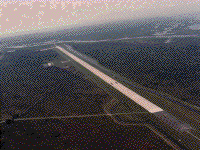 On the console adjacent to ours are the Landing Site Officers (LSO's). These are generally current or former Air Force personnel, who are responsible for maintaining or clearing the airspace around any potential landing site, dispatching the Search and Rescue forces for a bailout or a rough landing, and act as the first liaisons between NASA and wherever the shuttle may be forced to land. There are four LSO's working this mission.
On the console adjacent to ours are the Landing Site Officers (LSO's). These are generally current or former Air Force personnel, who are responsible for maintaining or clearing the airspace around any potential landing site, dispatching the Search and Rescue forces for a bailout or a rough landing, and act as the first liaisons between NASA and wherever the shuttle may be forced to land. There are four LSO's working this mission.
Finally, there are four Navigation Support Officers, responsible for maintaining the on-board navigation (telemetry) and the ground navigation (tracking). In addition, we also have 3 computer people who make sure that the Ascent/Entry computers remain working; 2 Range Safety people, who track the falling SRB's and ET and notify any country that may be in the way if something happens; and one "MPSR policeman" who keeps traffic flowing in the room and makes sure that no unauthorized people are there.
I work in the Flight Design and Dynamics Division, which is subdivided into the Design section and the Operations (OPS) section. When I'm not working in MCC, I work in Ascent Flight Design. The Ascent team mentioned above work with me there, as does Abort Support. The Entry Support and the Entry team work in Descent Flight Design, and the ARD Support and LSO's work in the OPS group. The Nav people are a quasi mixture of both design and ops.
There are 4 main objectives to this mission. In order, they are:
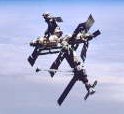
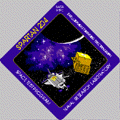
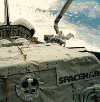
- rendezvous with Mir, to demonstrate techniques for future missions
- SPARTAN deploy and retrieve, which is astrophysics on a payload
- SPACEHAB, which is small experiments inside the shuttle
- an EVA (spacewalk) for two astronauts to demonstrate mass handling
Finally, this marks the first flight with a woman shuttle Pilot (Lt. Col. Eileen Collins). After two or so missions, she will be eligible to command a mission. Also, this will be the first African-American to spacewalk (Dr. Bernard Harris, MD). This is also the second flight with a Russian Cosmonaut as a guest traveller (Vladimir Titov).
OK, so that's the background, the dramatis personae if you will. Now we'll get down to the countdown.
January 31, 1995: L - 1 Day.
 The "Day-of-Launch" (DOL) support really starts the day before launch. We usually come in about 24 hours before liftoff for the Systems and Weather briefings. For this mission, since it's a relatively late liftoff time of 23:47:44 CST on Feb. 1 (05:47:44 GMT on Feb. 2), we came in at 07:00 CST on January 31 (from here on, all times will be in CST). This is nice: a typical launch is around 7:00 AM, which means that I have to be here at 1:30 AM. That plays hell with my sleep schedule: I have to go to bed the night before at 5:00 PM and get up around 11:30 PM, and it takes about 3 days to adjust. The early launch provides a short (about 3-4 hours) window in which all of the TAL sites in Europe and Africa are lighted, in which the launch site is lighted, but not too late so that the winds around the Cape pick up.
The "Day-of-Launch" (DOL) support really starts the day before launch. We usually come in about 24 hours before liftoff for the Systems and Weather briefings. For this mission, since it's a relatively late liftoff time of 23:47:44 CST on Feb. 1 (05:47:44 GMT on Feb. 2), we came in at 07:00 CST on January 31 (from here on, all times will be in CST). This is nice: a typical launch is around 7:00 AM, which means that I have to be here at 1:30 AM. That plays hell with my sleep schedule: I have to go to bed the night before at 5:00 PM and get up around 11:30 PM, and it takes about 3 days to adjust. The early launch provides a short (about 3-4 hours) window in which all of the TAL sites in Europe and Africa are lighted, in which the launch site is lighted, but not too late so that the winds around the Cape pick up.
07:00:00, T - 15:30:00 and counting (L - 40:47:44)
The difference between the launch countdown and the timer countdown is that the "T minus" time has built-in holds accounted for. Therefore there are about 25 hours of hold time between now and liftoff.
Remember all the people I just mentioned? Well, for the L - 1 day briefings, there are only a few controllers: the four at my console station, one Entry Support person, three Ascent Support people, and one LSO. The crowd will start to trickle in tomorrow afternoon, about 4:00 PM.
The briefings start about 15 minutes after we get on console; the Flight Director (the guy who's in charge of the MCC) wants to make sure that everyone from the Ascent Team is there and ready, having taken over for the previous team (Planning Shift). The Systems briefing comes first; it's about 20 minutes long meeting via telecon between the crew in Florida and the flight controllers in Houston. Here's where the controllers answer all final questions about various software and hardware problems, fixes, patches, and warnings of things to expect to see that are not serious. The payloads people are also involved here, telling the crew about any last-minute changes or configurations that they may need to know about.
 Next is the Weather briefing. We get reports from people stationed at all the TAL sites (each site has an astronaut there flying planes, making sure that the airport is adequate in terms of current and forecast weather and visibility) and the AOA, RTLS, and launch sites. Right now, all the weather is fine, and it looks good for launch in 24 hours. The weather briefing lasts about 20 minutes as well, and the crew is released at about 08:00 AM. Afterwards, the weather is discussed some more, and the bottom line is that it looks good everywhere except for some fog at the TAL sites in Spain.
Next is the Weather briefing. We get reports from people stationed at all the TAL sites (each site has an astronaut there flying planes, making sure that the airport is adequate in terms of current and forecast weather and visibility) and the AOA, RTLS, and launch sites. Right now, all the weather is fine, and it looks good for launch in 24 hours. The weather briefing lasts about 20 minutes as well, and the crew is released at about 08:00 AM. Afterwards, the weather is discussed some more, and the bottom line is that it looks good everywhere except for some fog at the TAL sites in Spain.
The Flight Director, before releasing us from console, gives a pep talk. Referring to the anniversaries last weekend of the Challenger and Apollo 1 accidents, as well as the launch failure in China last week that killed 6 people, he told us that "your job is to be ready. Go over everything here on console, go back to your offices and go over everything there, make sure you're as ready as possible for whatever happens. Just because this is the 67th shuttle launch, it does not mean less attention has to be paid. I know you'll do your best; I've worked with some of you for years. Get some rest tomorrow and I'll see you on console tomorrow night at 6 PM."
One final job needs to be accomplished: we get the latest state vector (position and velocity) from Mir, and run our processors to find the exact time we need to lift off. The updated time is now 05:47:43 GMT on February 1, 1995. We leave console at 10:30 AM; T - 12 hours and counting.
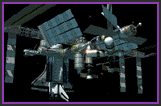
 Everything looks good for a launch on time. We're all excited; we can feel the nervous tension that accompanies every launch, though it's a good tension. This is my 8th launch, dating back to 1991, and each one is different and challenging in its own way. This one, though, is special due to its high-profile rendezvous. Mess this one up, and the Space Station could be in trouble. I also worked the Hubble Telescope mission in Dec. 1993, and this one is just as big and important. This mission is a symbol, the Next Big Thing for NASA to do. Time to go back to work. Tonight I'll go home and relax for a little bit; I have to stay up a bit later than normal to adjust for the next day, since a successful launch will send us home at around 1:30 AM. Launch day I think I'll sleep late and go in for a few hours after lunch.
Everything looks good for a launch on time. We're all excited; we can feel the nervous tension that accompanies every launch, though it's a good tension. This is my 8th launch, dating back to 1991, and each one is different and challenging in its own way. This one, though, is special due to its high-profile rendezvous. Mess this one up, and the Space Station could be in trouble. I also worked the Hubble Telescope mission in Dec. 1993, and this one is just as big and important. This mission is a symbol, the Next Big Thing for NASA to do. Time to go back to work. Tonight I'll go home and relax for a little bit; I have to stay up a bit later than normal to adjust for the next day, since a successful launch will send us home at around 1:30 AM. Launch day I think I'll sleep late and go in for a few hours after lunch.
February 1, 1995: Launch Day (take 1).
Of course, we don’t even get to go on console today. The launch attempt was scrubbed early for weather problems, and we’ll have to try again tomorrow. I go in for one more set of launch window computer runs, and we find out that the new launch time is now 05:22:05 GMT on February 2, 1995.
February 2, 1995: Launch Day (take 2).
Well, Launch Night, really. It's a nice way to start the day-- since the launch is at night, I get to sleep in. I'm a night owl, anyway. The day is mine, as all my hours will be at night.
2:00 PM. T - 3:00 and holding (L - 9:22:05).
I leave work, getting the afternoon off. That's kinda nice. So I take my dog, a George Thorogood CD, and a stack of comics and go to the park for an hour. B-b-b-b-b-b-bad.....
5:30 PM. T - 3:00 and holding (L - 5:52:05).
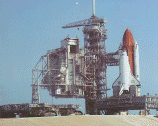 I get to MCC after dinner and check in with the rest of the Ascent team. We are currently in the T - 3 hour hold. The countdown clock, measured in "T minus" time, represents the liftoff time, but includes several built-in holds. This one, for example, is to finish the tanking procedures, in which the liquid hydrogen and oxygen fuels are being loaded. The "L minus" time is the true clock time until launch. When we come out of the T - 3 hour hold, at 7:32:04 PM, it is actually L - 3:50. The extra 50 minutes are built-in holds later in the count. The T - 3 hour hold lasts for two hours.
I get to MCC after dinner and check in with the rest of the Ascent team. We are currently in the T - 3 hour hold. The countdown clock, measured in "T minus" time, represents the liftoff time, but includes several built-in holds. This one, for example, is to finish the tanking procedures, in which the liquid hydrogen and oxygen fuels are being loaded. The "L minus" time is the true clock time until launch. When we come out of the T - 3 hour hold, at 7:32:04 PM, it is actually L - 3:50. The extra 50 minutes are built-in holds later in the count. The T - 3 hour hold lasts for two hours.
5:45 PM. T - 3:00 and holding (L - 5:37:05).
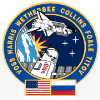 The astronauts wake up. The crew has a traditional steak and eggs breakfast, and for dessert, a cake decorated with the mission patch. After eating, it's time to put on the orange suits.
The astronauts wake up. The crew has a traditional steak and eggs breakfast, and for dessert, a cake decorated with the mission patch. After eating, it's time to put on the orange suits.
6:15 PM. T - 3:00 and holding (L - 5:07:05).
 The 7-member Inspection Team has been on the launch pad since about 4:30. They check the integrity of the Thermal Protection System (insulation) on the External Tank, as well as looking for ice, frost, and other debris. Tomorrow they will look at high-speed videos of the launch to look for damage or debris.
The 7-member Inspection Team has been on the launch pad since about 4:30. They check the integrity of the Thermal Protection System (insulation) on the External Tank, as well as looking for ice, frost, and other debris. Tomorrow they will look at high-speed videos of the launch to look for damage or debris.
6:30 PM. T - 3:00 and holding (L - 4:52:04).
We run our Launch Window processor with the latest Mir state vector, and it says the new launch time is 05:22:04 GMT on Feb. 3 (11:22:04 PM CST on Feb. 2). The new time is passed to the launch control people in Florida so they can reset their countdown clocks.
6:52 PM. T - 3:00 and holding (L - 4:40:04).
 We have our first weather briefing of the day; there will be one more later. All the sites still look fine for RTLS, AOA, TAL, and launch. There is a high pressure system over the Gulf of Mexico that is bringing clear weather in Florida, and another in the Rockies that is clearing away Edwards Air Force Base in California. The TAL site in Zaragoza, Spain is current and forecast GO, but the TAL site in Moron, Spain is fogged in. The TAL site in Ben Guerir, Morocco is clear, so is current and forecast GO. The astronauts receive the winds and runway updates. Ten minutes later, the crew is off to the suiting room; the weather briefing lasts another five minutes without them.
We have our first weather briefing of the day; there will be one more later. All the sites still look fine for RTLS, AOA, TAL, and launch. There is a high pressure system over the Gulf of Mexico that is bringing clear weather in Florida, and another in the Rockies that is clearing away Edwards Air Force Base in California. The TAL site in Zaragoza, Spain is current and forecast GO, but the TAL site in Moron, Spain is fogged in. The TAL site in Ben Guerir, Morocco is clear, so is current and forecast GO. The astronauts receive the winds and runway updates. Ten minutes later, the crew is off to the suiting room; the weather briefing lasts another five minutes without them.
7:14 PM. T - 3:00 and holding (L - 4:08:04).
 We see the crew being suited up in their orange Launch and Escape suits. The closed-circuit TV shows each astronaut being helped on with the suit, as the Public Affairs Officer (PAO) describes a little about each one-- military rank if any, previous shuttle missions, education, etc. Meanwhile, the Public Affairs Officer tells the world that the SRB recovery ships are stationed 163 miles NNE of the Cape; the SRB's are separated at an altitude of 30 miles, but will continue to 42 miles before falling into the ocean 7 minutes later at 60 miles per hour (with parachutes) seven miles apart.
We see the crew being suited up in their orange Launch and Escape suits. The closed-circuit TV shows each astronaut being helped on with the suit, as the Public Affairs Officer (PAO) describes a little about each one-- military rank if any, previous shuttle missions, education, etc. Meanwhile, the Public Affairs Officer tells the world that the SRB recovery ships are stationed 163 miles NNE of the Cape; the SRB's are separated at an altitude of 30 miles, but will continue to 42 miles before falling into the ocean 7 minutes later at 60 miles per hour (with parachutes) seven miles apart.
7:32 PM. T - 3:00 and counting (L - 3:50:04).
As we come out of the T - 3:00 hold, the crew heads for the "Astrovan". This is a common site for the media, as the astronauts come off the elevator in their orange Launch and Escape Suits, waving to the crowd. It is the last time anyone other than the drivers and the orbiter close-out crew will see them in person before landing. Then they leave for the Pad. The LES suits look bulky on the astronauts; these are functional, not comfortable. The astronauts also wear Depends adult diapers, since they will be sitting on the launch pad on their backs for at least four hours.
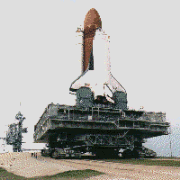 The bus ride is about 15 minutes from the Operations and Checkout Building to Launch Pad 39B, where the crew exits the van and takes an elevator ride to the top. Launch Complex 39 (which also includes pad 39A a couple miles south) was also used to launch the Saturn V rockets to the moon 25 years ago. The pads, the Mobile Launch Platforms, and the Crawler-Transporters, were all refurbished
in the late 70's to launch shuttles. The MLP's are huge platforms on which the shuttle sits, placed there in the Vehicle Assembly Building (VAB); that's the big white building with the Bicentennial Star on it. They used to stack the Saturn V there.
The bus ride is about 15 minutes from the Operations and Checkout Building to Launch Pad 39B, where the crew exits the van and takes an elevator ride to the top. Launch Complex 39 (which also includes pad 39A a couple miles south) was also used to launch the Saturn V rockets to the moon 25 years ago. The pads, the Mobile Launch Platforms, and the Crawler-Transporters, were all refurbished
in the late 70's to launch shuttles. The MLP's are huge platforms on which the shuttle sits, placed there in the Vehicle Assembly Building (VAB); that's the big white building with the Bicentennial Star on it. They used to stack the Saturn V there. 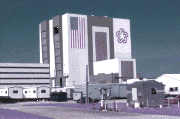 The crawler moves the orbiter and MLP out to the pad about a month before launch, at the top speed of 2 miles per hour, with the shuttle stack (shuttle, SRB's, and ET) perched upright.
The crawler moves the orbiter and MLP out to the pad about a month before launch, at the top speed of 2 miles per hour, with the shuttle stack (shuttle, SRB's, and ET) perched upright.
For the first time, NASA will be launching not on an even minute. That's because the launch window is only (and exactly) five minutes long. A typical launch window is between 1:00:00 and 2:30:00, so they have the luxury of rounding to a nice round even number; if this were typical, we'd launch at 11:23:00 PM, not 11:22:04. But since the window is five minutes, that 56 seconds represents a significant part of the launch capability.
By this time, I have done my first task, to check the database. The Mission Operations Computer (MOC) has a huge database with values provided by a number of different disciplines for various reasons: mine, for example, deal primarily with the OMS burn targets, which are software values that tell the shuttle how, when, and where to burn the engines to come home, given various different situations. This takes me about 20 minutes to verify. I give the FDO my OK when I'm done.
7:48 PM. T - 2:44:04 and counting (L - 3:34:04 and counting).
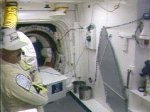 Once the crew gets to the orbiter, they are helped in, one at a time, by the closeout crew. These people are all contractors but one; the one is an astronaut. This crew preps the departing astronauts with their suit, and helps them get into the orbiter. This whole process takes about an hour. Then they close and latch the hatch at 9:10 PM, and the crew is in there for good. Unless there is a problem that scrubs the launch, they won't breathe fresh air for 10 days.
Once the crew gets to the orbiter, they are helped in, one at a time, by the closeout crew. These people are all contractors but one; the one is an astronaut. This crew preps the departing astronauts with their suit, and helps them get into the orbiter. This whole process takes about an hour. Then they close and latch the hatch at 9:10 PM, and the crew is in there for good. Unless there is a problem that scrubs the launch, they won't breathe fresh air for 10 days.
9:00 PM. T - 1:32:04 and counting (L - 2:22:04).
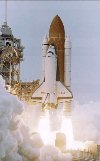 The Launch Systems Evaluation Advisory Team, or LSEAT, makes its decision on which I-loads to use. I-loads are values calculated by Flight Design much earlier in the design phase, values which are placed into the shuttle's computer memory that tell it exactly how to fly the Ascent trajectory. Due to the Day-of-Launch (DOL) winds and atmosphere, the Ascent team (remember them from the cast of characters?) has been running evaluation programs to determine whether the DOL aerodynamic loads will be outside of the limits. If they are, then we will have to use a new set of I-loads that are optimized for these winds. The reason we don't always use them is that we would have to uplink the new values to the shuttle, and there's always a risk in that. The LSEAT decides, based on the Ascent Team's recommendations, to go with the pre-designed set due to upper level winds at KSC.
The Launch Systems Evaluation Advisory Team, or LSEAT, makes its decision on which I-loads to use. I-loads are values calculated by Flight Design much earlier in the design phase, values which are placed into the shuttle's computer memory that tell it exactly how to fly the Ascent trajectory. Due to the Day-of-Launch (DOL) winds and atmosphere, the Ascent team (remember them from the cast of characters?) has been running evaluation programs to determine whether the DOL aerodynamic loads will be outside of the limits. If they are, then we will have to use a new set of I-loads that are optimized for these winds. The reason we don't always use them is that we would have to uplink the new values to the shuttle, and there's always a risk in that. The LSEAT decides, based on the Ascent Team's recommendations, to go with the pre-designed set due to upper level winds at KSC.
At this time, crew and ground personnel (at KSC and JSC) are alo performing voice checks on the three air-to-ground loops. There are three air-to-ground "loops", or communications protocols, in case one should fail. There is also an air-to-air loop. Each crew member in turn verifies that his or her voice can be heard on all three loops, individually and simultaneously. Additionally, NORAD reports that the shuttle will not come close to any trackable debris in space during the first few hours of the mission.
9:15 PM. T - 1:17:04 and counting (L - 2:07:04).
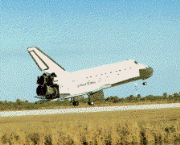 The phone rings. It's someone in Ben Guerir, Morocco, wanting to know the results of the latest weather balloon data that was taken there. I pass it to the appropriate personnel.
The phone rings. It's someone in Ben Guerir, Morocco, wanting to know the results of the latest weather balloon data that was taken there. I pass it to the appropriate personnel.
Time for the second weather briefing of the night. We hear from the representatives at the TAL sites in Spain and Africa, who say that it all looks good to them (except for fogged-in Moron, Spain). Then the Weather folks come on the loops, and show us satellite movies of the last few hours. These forecasters give us the predicted weather at liftoff time and whichever landing time would be appropriate (a TAL takes about 25 minutes, RTLS about 20, and AOA about 90). A bad forecast by these guys can be enough to scrub a launch, but fortunately, they give their go. We'll get one final briefing at L - 45 minutes. If we had to change AOA sites, then I would have had to re-verify another set of targets in the MCC database.
9:20 PM. T - 1:12:04 and counting (L - 2:02:04).
Time for a cabin leak check. They overpressurize the ship; normal atmospheric pressure is 14.7 psi, same as on Earth, but now they increase the pressure to 16.7 psi. If there are any small leaks, this will reveal them. Fortunately, nothing shows up on the monitors. A half-hour later, they vent the atmosphere back down to the normal levels.
Ten minutes later, the Range Safety radio test is in work. The Range is responsible for protecting the coast from falling debris; if anything looks like it's coming over land, the Range Safety Officer can send a destruct signal. Meanwhile, the closeout crew packs up the White Room and leaves. Now the crew is all alone up there.
9:47 PM. T - 0:45:04 and counting (L - 1:35:04).
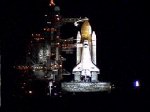 Final reports from the MILA tracking station. The air-to-ground voice data and telemetry is good. MILA, near the Cape, is responsible for tracking the shuttle for the first 6-1/2 minutes, then it's handed over to a Bermuda tracking station until 11 minutes after launch. After that, the Tracking and Data Relay Satellite System (TDRSS) takes over in orbit. Time also for the final Collision Avoidance data (COLA); NORAD in Colorado compares the shuttle's predicted orbit against the database of everything in orbit (that's anything bigger than one centimeter) to make sure the shuttle doesn't come statistically close. If there is a predicted near-miss, then the shuttle will hold on the pad until it's clear.
Final reports from the MILA tracking station. The air-to-ground voice data and telemetry is good. MILA, near the Cape, is responsible for tracking the shuttle for the first 6-1/2 minutes, then it's handed over to a Bermuda tracking station until 11 minutes after launch. After that, the Tracking and Data Relay Satellite System (TDRSS) takes over in orbit. Time also for the final Collision Avoidance data (COLA); NORAD in Colorado compares the shuttle's predicted orbit against the database of everything in orbit (that's anything bigger than one centimeter) to make sure the shuttle doesn't come statistically close. If there is a predicted near-miss, then the shuttle will hold on the pad until it's clear.
The Superintendent of Range Operations reports that the Range is ready for launch: the downrange shipping lanes are clear, the SRB splashdown areas are clear, and the Eastern Space and Missile Complex is prepared for tracking.
10:08 PM. T - 0:24:04 and counting (L - 1:14:04).
Based on the weather briefing, the crew will update their software and checklists. For example, a TAL runway may change or the launch site barometric pressure may require updating, and they are available through simple computer commands. Meanwhile, on the ground, the flight controllers monitor the crew's actions in case they accidentally input a wrong parameter. Then the cabin vent valves are closed.
10:12:04 PM. T - 0:20:00 and holding (L - 1:10:00).
We now enter in to a planned 10 minute hold. Time for a trajectory update, with further parameter configurations from MCC. We come out of it at L - 1:00:00, at 10:22:04 PM.
10:27:04 PM. T - 0:15:00 and counting (L - 0:55:00).
Final weather update, if required. Any final changes to abort site ( RTLS, TAL, AOA) winds, runways, and/or altimeter are loaded in now.
10:33:04 PM. T - 0:09:00 and holding (L - 0:49:00).
For this mission, and for all subsequent Mir rendezvous missions, there will be a 40 minute hold at the T - 9:00 minute mark. A typical launch will have two built-in 10-minute holds, one each at T - 20:00 and T - 9:00. Since the window today is so small, we combine all the holds and add another 20 minutes of hold time. During these holds, the crews -- the launch crew, the astronaut crew, and the MCC crew -- can work any last-minute hardware or software problems that may pop up. Timing is critical: we can't afford to delay very long, or we run out of launch window, so we front-load trouble-shooting time.
11:02:04 PM. T - 0:09:00 and holding (L - 0:20:00).
 The Flight Director begins polling the MCC flight controllers, to ensure that each is "GO" for launch in his or her respective area. The FDO asks us if we're ready. "TARGETING's GO, FDO" is my reply, and the other backroom controllers similarly answer. Finally, the entire MPSR has given their assent, and when his turn comes, FDO gives a "GO" to the Flight Director. Each front room controller is doing the same thing with their back rooms, and soon MCC is "GO". Other than that, it's pretty quiet. There's the usual little bit of nervous tension to keep us on our toes.
The Flight Director begins polling the MCC flight controllers, to ensure that each is "GO" for launch in his or her respective area. The FDO asks us if we're ready. "TARGETING's GO, FDO" is my reply, and the other backroom controllers similarly answer. Finally, the entire MPSR has given their assent, and when his turn comes, FDO gives a "GO" to the Flight Director. Each front room controller is doing the same thing with their back rooms, and soon MCC is "GO". Other than that, it's pretty quiet. There's the usual little bit of nervous tension to keep us on our toes.
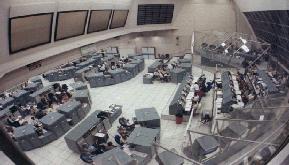 Back in Florida, the launch controllers are told to disable the ringers on their phones, and that they will not be allowed to enter or exit the launch complex once the clock restarts. On behalf of the launch team, the shuttle commander is wished a safe and successful trip.
Back in Florida, the launch controllers are told to disable the ringers on their phones, and that they will not be allowed to enter or exit the launch complex once the clock restarts. On behalf of the launch team, the shuttle commander is wished a safe and successful trip.
The Launch Director polls his room at KSC; they've got their own alphabet soup of controllers. OTC, TBC, PTC, LPS, MILA, SDM, Safety, SBE, CDR, LRD, SRO: each one there is ready to go. He asks FLIGHT if he's ready to go, and FLIGHT answers that Houston's ready. Then he polls the Launch Management team: the Payload Ops Director, Engineering Director, Safety/Quality Director, Cape Weather, and Operations Manager. Each gives a "GO".
Now that everyone is ready, willing, and able, the Launch Director takes a moment out to wish the crew luck. This is a tradition dating back many years, as the crew receives a message of good luck. The crew, in turn, thanks everyone at the Cape for all their hard work in getting the "bird" ready to fly.
Discovery is given the "GO" to launch on time, and the countdown clock picks back up.
11:13:04 PM. T - 0:09:00 and counting.
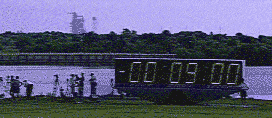 This is it, there are no more built-in hold times left. There's not much left for anyone to do now, except carefully watch the monitors of their systems to make absolutely sure that nothing -- absolutely nothing -- is wrong or out of spec.
This is it, there are no more built-in hold times left. There's not much left for anyone to do now, except carefully watch the monitors of their systems to make absolutely sure that nothing -- absolutely nothing -- is wrong or out of spec.
The Ground Launch Sequencer (GLS) starts at the T - 9:00 mark. This means that from now on, all events are controlled by the computers on the ground. Until the T - 31 second mark, though, the launch controllers at the Cape or the flight controllers at MCC can request a hold, but it better be a good reason. There is an entire section of the Flight Rules, a 2-volume document that describes in general what may or may not be allowed to happen, and why, devoted to launch procedures, and if a Flight Rule is violated, the launch may be scrubbed, like it or not.
It's getting real quiet in the MPSR. All of the flight controllers who are finished with their jobs for the moment -- the Entry Support and Ascent Support folks -- hang back and watch the monitors. Only the people directly on console say anything.
11:14:34 PM. T - 0:07:30 and counting.
The orbiter access arm begins to retract. This is the arm that contains the room where the close-out crew helped the astronauts enter the orbiter. The arm slowly moves out of the way, though it can be moved back quickly if the crew has to depart for any reason (an emergency, a pad abort, etc.).
The crew moves their seats into the launch position, if they have been moved since entry. This is the equivalent of "Please return your seats to their full upright position and stow your tray tables" in preparation for launch. Then they check their Launch and Escape Suit zippers and gloves, and cinch down the shoulder harness and lap belts. They need all this protection, as they will be traveling up to 3-g's (that's three times the force of gravity) within minutes.
11:18:39 PM. T - 0:03:25 and counting.
The Main Engines go through a prelaunch gimbal check, to verify that they will be able to move properly during Ascent. This consists of an up-and-down, side-to-side motion, until the engines are moved to the start position. Shortly afterwards, the shuttle goes completely on internal power.
11:18:00 PM. T - 0:03:00 and counting.
The External Tank liquid hydrogen and oxygen are at flight pressure. The Gaseous Oxygen Vent Hood is retracted; this looks like a "beanie cap" on the ET. "Drainback" starts now: we have only a few minutes to hold, or else too much propellant will have evaporated.
11:20:04 PM. T - 0:02:00 and counting.
Time for suit prep. The crew closes and locks their visors, and opens the suit oxygen supply. Each crew member is now isolated in their suit, and that's the last action anyone has to do. The Orbiter Test Conductor, who is giving the crew these instructions, wishes them a final "have a great flight".
11:21:04 PM. T - 0:01:00 and counting.
The Ground Launch Sequencer verifies that the Main Engines are ready, and turns the heaters off the Solid Rocket Boosters. These heaters were added after the Challenger accident.
11:21:33 PM. T - 0:00:31 and counting.
We've just passed the point of no return in the countdown. The launch controllers decided that any problem that occurs within the last half-minute cannot be resolved in the time available, so a strict set of rules was created that will halt the launch if any of its criteria are violated.
This is the point at which my heartbeat starts to go up. If we've made it this far, chances are we're going to launch. Up until now, we've been just watching the video feed of the orbiter; now we have to turn it off and pay attention to our screens of data. I don't get to watch the launch live.
11:21:49 PM. T - 0:00:15 and counting.
The Sound Suppression Water System begins. This dumps thousands of gallons of water beneath the launch pad, for two reasons: to soak up the sound and to dampen the shock waves from the main engines.
11:21:54 PM. T - 0:00:10 and counting.
The igniters come on. These look like sparklers, but they burn off any excess hydrogen before the engines start at T - 5.6 seconds. It takes that long to throttle up to 100%.
T - 9...
8...
7...
6...
We've gone for main engine start....
We have main engine start....
3...
2...
1...
Liftoff!
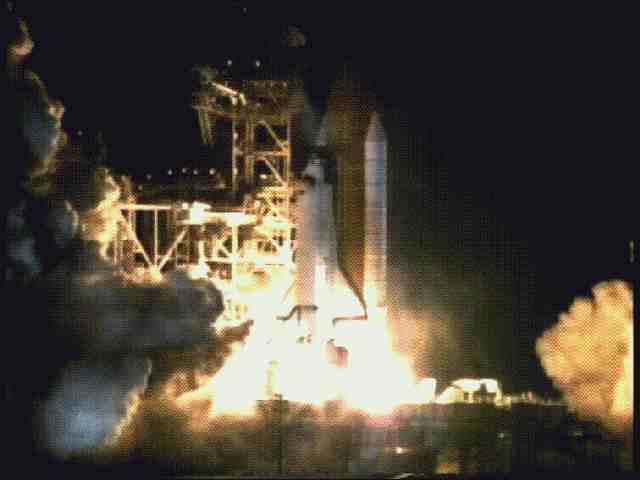
Back to the Home Page
Comments? Suggestions? Send 'em to me at WizardImps@hotmail.com
 Page content and layout © 1996-2000 Michael Grabois and Astra Enterprises.
Page content and layout © 1996-2000 Michael Grabois and Astra Enterprises.
Last updated: August 7, 2000



 First, I must give you some background into what I do in
First, I must give you some background into what I do in 
 Behind me is the Entry Support team, which is analyzing the winds and weather data at all the
Behind me is the Entry Support team, which is analyzing the winds and weather data at all the  Next to them is the Ascent Support team, which is looking at the winds and
Next to them is the Ascent Support team, which is looking at the winds and  On the console adjacent to ours are the Landing Site Officers (LSO's). These are generally current or former Air Force personnel, who are responsible for maintaining or clearing the airspace around any potential landing site, dispatching the Search and Rescue forces for a bailout or a rough landing, and act as the first liaisons between
On the console adjacent to ours are the Landing Site Officers (LSO's). These are generally current or former Air Force personnel, who are responsible for maintaining or clearing the airspace around any potential landing site, dispatching the Search and Rescue forces for a bailout or a rough landing, and act as the first liaisons between 


 Next is the
Next is the 
 Everything looks good for a launch on time. We're all excited; we can feel the nervous tension that accompanies every launch, though it's a good tension. This is my 8th launch, dating back to 1991, and each one is different and challenging in its own way. This one, though, is special due to its high-profile rendezvous. Mess this one up, and the
Everything looks good for a launch on time. We're all excited; we can feel the nervous tension that accompanies every launch, though it's a good tension. This is my 8th launch, dating back to 1991, and each one is different and challenging in its own way. This one, though, is special due to its high-profile rendezvous. Mess this one up, and the  I get to
I get to  The astronauts wake up. The crew has a traditional steak and eggs breakfast, and for dessert, a cake decorated with the
The astronauts wake up. The crew has a traditional steak and eggs breakfast, and for dessert, a cake decorated with the  The 7-member Inspection Team has been on the launch pad since about 4:30. They check the integrity of the Thermal Protection System (insulation) on the
The 7-member Inspection Team has been on the launch pad since about 4:30. They check the integrity of the Thermal Protection System (insulation) on the  We have our first
We have our first  We see the crew being suited up in their orange Launch and Escape suits. The closed-circuit TV shows each astronaut being helped on with the suit, as the Public Affairs Officer (PAO) describes a little about each one-- military rank if any, previous shuttle missions, education, etc. Meanwhile, the Public Affairs Officer tells the world that the
We see the crew being suited up in their orange Launch and Escape suits. The closed-circuit TV shows each astronaut being helped on with the suit, as the Public Affairs Officer (PAO) describes a little about each one-- military rank if any, previous shuttle missions, education, etc. Meanwhile, the Public Affairs Officer tells the world that the  The bus ride is about 15 minutes from the Operations and Checkout Building to
The bus ride is about 15 minutes from the Operations and Checkout Building to  The
The  Once the crew gets to the orbiter, they are helped in, one at a time, by the closeout crew. These people are all contractors but one; the one is an astronaut. This crew preps the departing astronauts with their suit, and helps them get into the orbiter. This whole process takes about an hour. Then they close and latch the hatch at 9:10 PM, and the crew is in there for good. Unless there is a problem that scrubs the launch, they won't breathe fresh air for 10 days.
Once the crew gets to the orbiter, they are helped in, one at a time, by the closeout crew. These people are all contractors but one; the one is an astronaut. This crew preps the departing astronauts with their suit, and helps them get into the orbiter. This whole process takes about an hour. Then they close and latch the hatch at 9:10 PM, and the crew is in there for good. Unless there is a problem that scrubs the launch, they won't breathe fresh air for 10 days.
 The Launch Systems Evaluation Advisory Team, or LSEAT, makes its decision on which I-loads to use. I-loads are values calculated by Flight Design much earlier in the design phase, values which are placed into the shuttle's computer memory that tell it exactly how to fly the Ascent trajectory. Due to the Day-of-Launch (DOL) winds and atmosphere, the Ascent team (remember them from the cast of characters?) has been running evaluation programs to determine whether the DOL aerodynamic loads will be outside of the limits. If they are, then we will have to use a new set of I-loads that are optimized for these winds. The reason we don't always use them is that we would have to uplink the new values to the shuttle, and there's always a risk in that. The LSEAT decides, based on the Ascent Team's recommendations, to go with the pre-designed set due to upper level winds at
The Launch Systems Evaluation Advisory Team, or LSEAT, makes its decision on which I-loads to use. I-loads are values calculated by Flight Design much earlier in the design phase, values which are placed into the shuttle's computer memory that tell it exactly how to fly the Ascent trajectory. Due to the Day-of-Launch (DOL) winds and atmosphere, the Ascent team (remember them from the cast of characters?) has been running evaluation programs to determine whether the DOL aerodynamic loads will be outside of the limits. If they are, then we will have to use a new set of I-loads that are optimized for these winds. The reason we don't always use them is that we would have to uplink the new values to the shuttle, and there's always a risk in that. The LSEAT decides, based on the Ascent Team's recommendations, to go with the pre-designed set due to upper level winds at  The phone rings. It's someone in
The phone rings. It's someone in  Final reports from the
Final reports from the  Back in Florida, the launch controllers are told to disable the ringers on their phones, and that they will not be allowed to enter or exit the launch complex once the clock restarts. On behalf of the launch team, the shuttle commander is wished a safe and successful trip.
Back in Florida, the launch controllers are told to disable the ringers on their phones, and that they will not be allowed to enter or exit the launch complex once the clock restarts. On behalf of the launch team, the shuttle commander is wished a safe and successful trip.
 This is it, there are no more built-in hold times left. There's not much left for anyone to do now, except carefully watch the monitors of their systems to make absolutely sure that nothing -- absolutely nothing -- is wrong or out of spec.
This is it, there are no more built-in hold times left. There's not much left for anyone to do now, except carefully watch the monitors of their systems to make absolutely sure that nothing -- absolutely nothing -- is wrong or out of spec.

 Page content and layout © 1996-2000 Michael Grabois and Astra Enterprises.
Page content and layout © 1996-2000 Michael Grabois and Astra Enterprises.